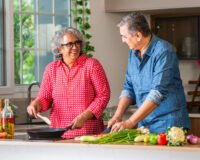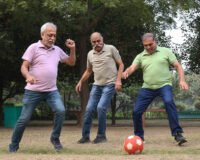Turning 50 (and beyond) doesn’t mean settling for sluggish energy. With a few smart, consistent habits—most of which are easy to support within premium retirement homes—you can keep your metabolism humming, feel stronger, and enjoy food and movement without extremes. If you’re exploring retirement homes in Delhi NCR, use this guide to shape questions for the wellness team and the dining staff, and to build a personal plan you can stick to safely.
What Is Metabolism—and How Can You Enhance It After Your 50s?
Metabolism is the sum of processes your body uses to convert food into energy. Most of your daily burn happens at rest (resting metabolic rate), with the rest coming from movement (steps, chores, exercise) and the “thermic” cost of digesting food—especially protein. After 50, metabolism tends to slow mainly because lean muscle mass decreases and many people move less. Hormonal shifts, sleep changes, and certain medications can add to the slowdown.
The good news: you can nudge metabolism upward at any age. The biggest levers are:
- Preserve and build muscle: Two to three weekly sessions of resistance work (bodyweight, resistance bands, light dumbbells, machines) signal your body to maintain lean mass—the engine that burns energy even at rest.
- Move more overall: Non-exercise activity (NEAT)—short walks after meals, stairs where safe, light chores, standing breaks—adds up to a meaningful daily burn.
- Eat enough protein (and spread it out): Protein helps keep muscle on, supports recovery, and slightly raises the thermic effect of food.
- Sleep and stress: Poor sleep and chronic stress can lower activity levels, increase cravings, and make muscle maintenance harder.
Within premium retirement homes, look for an environment that offers strength-training spaces, guided classes, safe walking paths, and a dining program ready to accommodate higher-protein, fiber-rich meals.
Why Protein Matters—And How to Get It in Premium Retirement Homes
Protein is the cornerstone of a midlife-and-beyond metabolism plan. It feeds your muscles, supports bone health, and helps you stay satisfied between meals. A practical target for many adults over 50 is 1.0–1.2 g protein per kg of body weight per day, spaced across meals (e.g., 25–30 g per meal)—but always follow your doctor’s guidance, especially if you have kidney or liver concerns.
In premium retirement homes, the dining team can be your ally:
- Ask what’s in every meal: Request posted protein counts or a weekly “macros” note. If it’s not standard, most kitchens can provide it.
- Vegan sources: Lentils, chickpeas, kidney beans, soy (tofu, tempeh), edamame, quinoa, peanuts, nut butters, and plant-based yogurts. Pair legumes with grains (e.g., rajma + rice) for a fuller amino acid profile.
- Non-vegetarian: Eggs, fish, chicken, and lean meats—grilled, baked, or lightly sautéed.
- Smart add-ons: If a meal looks light on protein, add a side of curd/paneer/eggs, a bowl of dal, or a soy snack. Keep roasted chana, nuts, or a high-protein yogurt in your room for convenient top-ups.
Building a Healthy and Safe Exercise Routine
Exercise after 50 should be safe, progressive, and enjoyable—and supported by on-site professionals when possible.
A simple weekly template (after medical clearance):
- Cardio (3–5x/week): 20–40 minutes of brisk walking, cycling, or low-impact aerobics. On some days, sprinkle in light intervals (e.g., 1 minute brisk, 2 minutes easy, repeat 6–8 times) within your comfort zone.
- Mobility & balance (daily, 5–10 minutes): Ankle circles, hip openers, thoracic twists, shoulder mobility, plus balance drills (tandem stance near a support, heel-to-toe walks). Do all of this only after consulting with a doctor and understanding whether it’s right for your body or not.
- Recovery: At least one full rest day; sleep 7–8 hours; hydrate well.
Within premium retirement homes, look for:
- Qualified instructors who can scale exercises and monitor form.
- Accessible spaces (handrails, non-slip floors, good lighting).
- Small-group classes (yoga, group physiotherapy) and open gym hours with staff oversight.
- Activity prompts—step challenges, walking clubs, or light sport leagues (carrom, table tennis) to keep you moving socially.
How Metabolism Differs for Women vs. Men—and How to Build It
Men typically start with more lean mass, so their baseline metabolism is often higher. Women, especially around peri- and post-menopause, face estrogen decline, which can reduce muscle mass, shift fat distribution, and affect appetite and sleep. The response, however, is similar for both—prioritize muscle, protein, and recovery—with a few nuances:
For women:
- Resistance training is non-negotiable: Aim for 2–3 total-body sessions weekly; consider a slightly higher protein target per meal to stimulate muscle protein synthesis.
- Support sleep and stress: Hot flashes, night sweats, or anxiety can erode recovery—use cooling bedding, calming breathwork, and discuss medical options with your clinician.
- Bone health: Include weight-bearing moves (walks, light loaded squats) and discuss vitamin D/calcium status with your doctor.
For men:
- Train consistently, not heroically: Avoid “weekend warrior” spikes that invite injury. Keep form strict and volume steady.
- Waist management: Even small losses of visceral fat from regular training and fiber-rich meals can improve metabolic health quickly.
- Screenings: Keep up with thyroid, lipid, and glucose checks; discuss any medications that affect weight or energy.
In both cases, a supportive environment—like that in premium retirement homes—makes consistency easier: scheduled classes, protein-forward dining, safe spaces, and a community that keeps you accountable.
Conclusion: Why Saral Satya Legacy (SSL) Is a Great Place to Thrive
Metabolism after 50 isn’t fate—it’s feedback. Feed your muscles, move often, sleep well, and manage stress, and your body responds at any age. At Saral Satya Legacy, our wellness calendar, safe training spaces, and chef-led menus make these habits simpler to adopt and maintain. If you’re exploring retirement homes in Delhi NCR, tour SSL to see how daily routines—strength classes, walking clubs, yoga, and flexible meal options—translate science into a lifestyle you’ll actually enjoy.
FAQs
1) Do I need supplements like protein powder or creatine to boost metabolism after 50?
Not necessarily. Many people meet protein needs with food; creatine can help strength in some adults but should only be used after medical clearance.
2) Is it ever too late to improve metabolism after 50?
No—muscle responds at any age. Start gradually with strength training, daily movement, adequate protein, sleep, and hydration (with your doctor’s approval).
3) Do I need to eat many small meals to keep metabolism high?
Not required. Choose the meal pattern you can sustain; focus on total daily protein, fiber-rich whole foods, and steady activity for the biggest impact.





